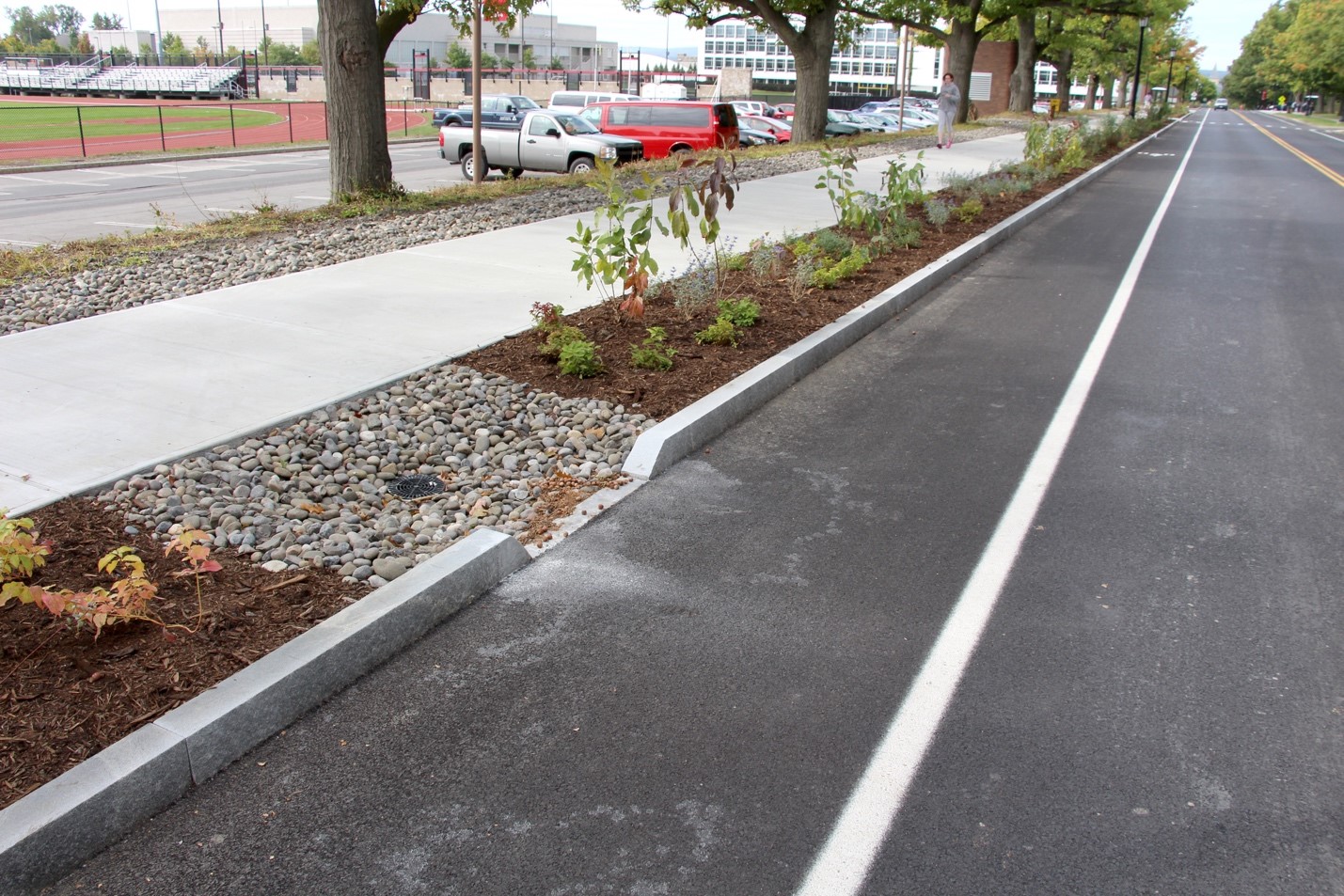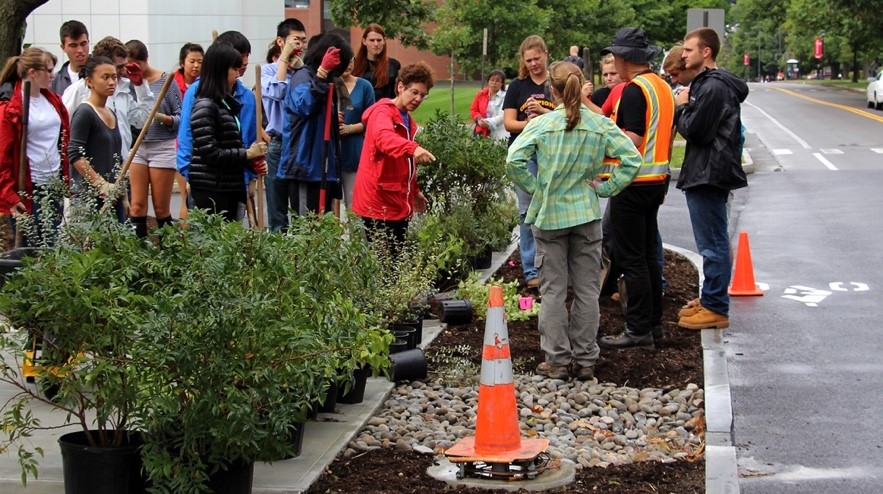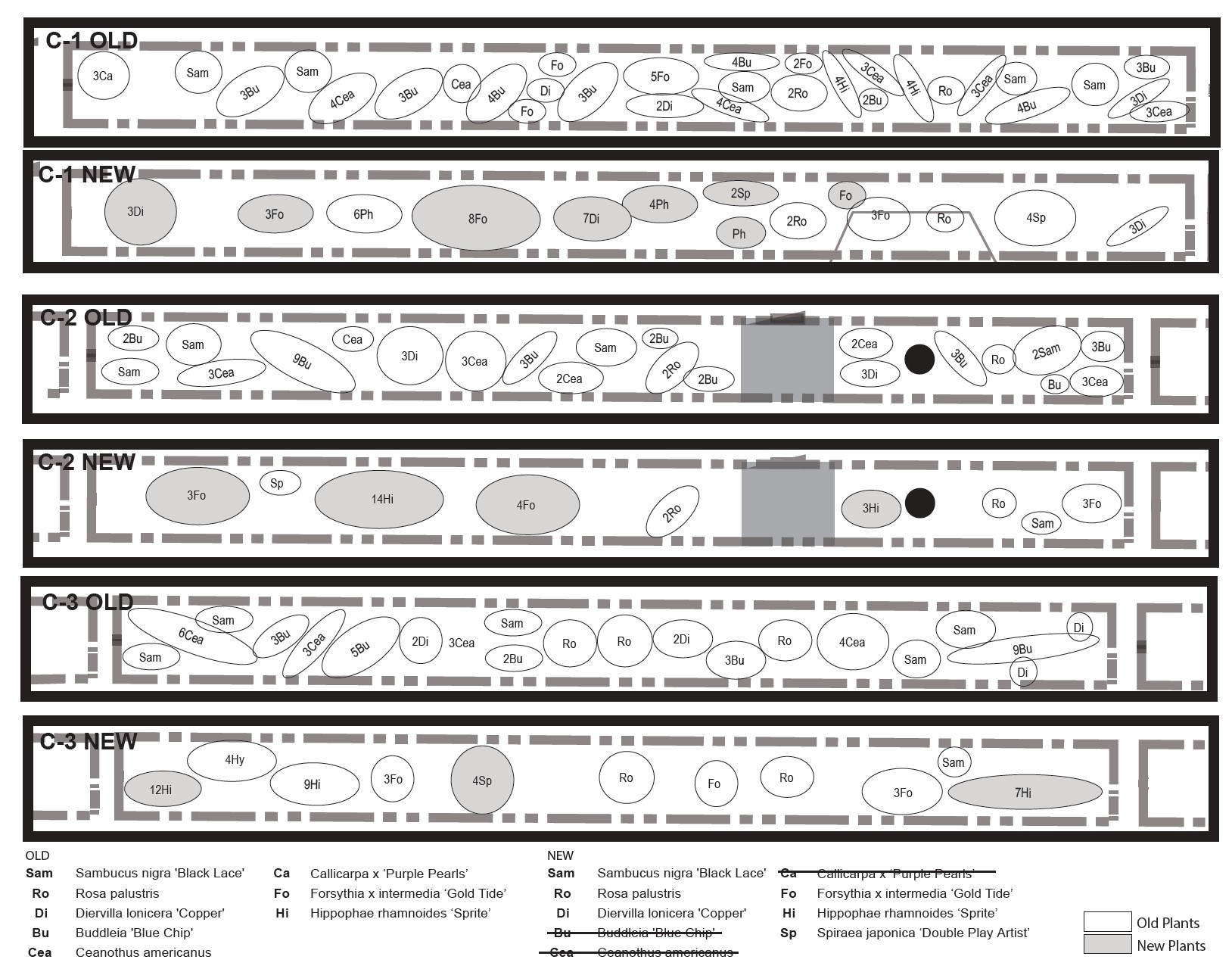![]()
Tower Road Bioswale
Sustainable Landscapes Trail at Cornell University
In all urban environments, adverse soil and water quality resulting from previous human activity and by the development of roads, buildings and other structures restricts plant establishment and growth, thus reducing or eliminating the ecosystem benefits we expect to receive from them. One urban soil restoration and remediation technique is to implement a bioswale in an area. A bioswale is a trench that is backfilled with porous materials and vegetation to reduce runoff and increase groundwater recharge. Along a road, curb cuts channel water into the prepared beds.
Return to Sustainable Landscape Trail Sites Homepage
Why is this site sustainable?
-
Reduces storm water runoff from Tower Rd into storm drains that empty into Cayuga Lake
- Allows precipitation and runoff to infiltrate into the roadside, recharging ground water
- Filters polluted runoff in the soil
- Supports diverse vegetation that uses precipitation and runoff.
- Provides habitat for insects and pollinators
- Is used as a teaching landscape to learn about plants appropriate for this use and to collect data on salt tolerance and plant growth in a road side setting.
- To allow students and the public learn how to implement bioswales such as this.
Bioswale Construction and Function
In the fall of 2014, a trench, called a bioswale was excavated approximately 0.6m deep x 1.5m wide and approximately 305m long on the south side of Tower Road. A shallow bed of gravel was placed at the bottom of the trench along with a wrapped perforated pipe (Figure 2). Sandy loam soil was filled in on top of this layer and curb cuts were made to allow road runoff to enter the adjacent 5-foot strip of soil. Thousands of plants were planted by Cornell students in the soil strip. In this bioswale shrub species were specifically chosen for their tolerance to road salt, both wet and dry soil conditions, and growth to a maximum height of no more than 1m. The plants were grouped in 5 different plant palettes and replicated 3 times. While most plants have survived the winter, the plants that were damaged overwinter were cut back to the soil in the spring and allowed to regrow. Other plants died out completely
Because of the very difficult winter of 2014-2015, some plant losses occurred, which were replaced with new plants in the fall and spring of 2015. In addition, the fall of 2015, 500 Allium gigantium ‘Purple Sensation’ were planted to replace some of the lost plants. Buddleia (Bu), Ceanothus americanus (Cea), and Callicarpa x “Purple Pearls” died off completely. In this stressful environment with large salt inputs, mounding of snow, and cold temperatures, it is understandable that some plants did not do well.
In 2018, we planted Berberis x 'NCXB’ , SUNJOY TODO, at the east end of the bioswale. This dwarf species is among the first generation of sterile barberries which negate the invasive properties of the non-improved species, Berberis thunbergii.
In 2016, over the course of 6 weeks, the amount of soluble salts in the soil of the bioswale were measured using a 1:2 dilution method.The results were measured in dS/m, or deci Siemens per meter.
|
Guidelines for soluble salts in soil (adapted from Dreistadt, 2001) |
|
|
1:2 Dilution Method |
|
|
Low fertility common |
< 0.38 dS/m |
|
Ideal |
0.38 – 0.75 |
|
Acceptable |
0.75 – 1.5 |
|
Unacceptable (salt injury common) |
> 1.5 |
-
Shining Sumac( Rhus copallina)
- Gold Tide Forsythia (Forsythia x intermedia ‘Corutasol’)
- Bayberry (Morella Pensylvanica )
- Sem False Aralia (Sorbaria sorbifolia ‘Sem’)
- Dwarf Sea Buckthorn (Hippophae rhamnoides ‘Sprite’)
- Buttonbush (Cephalanthus occidentalis)
- Goundseltree or Eastern Baccharis ( Baccharis halimifolia)
- Creeping willow,( Salix repens)
- Southern Bush Honeysuckle Copper’
- (Diervilla lonicera/Copper’)
- Nugget Ninebark (Physocarpus opulifolius ‘Nugget’)
- Rosa palustris
The following plants did not perform well or died
-
Spirea species ( Spiraea japonica)
- New Jersey Tea (Ceanothus americanus) Butterfly Bush( Budleia spp)
- Purple Pearls Callipcarpa ( Callicarpa x ‘Purple Pearls’)
This bioswale on Tower Road provides a demonstration of green infrastructure, and a practical application for large and small communities. It provides stormwater run-off reduction, storage and infiltration into the ground. This system incorporates designed soils with high infiltration that filter water and trap pollutants along with carefully selected plant materials that slow the runoff and use it during transpiration. Salt levels in the soil, plant growth and plant performance will continue to be measured in the coming years.



